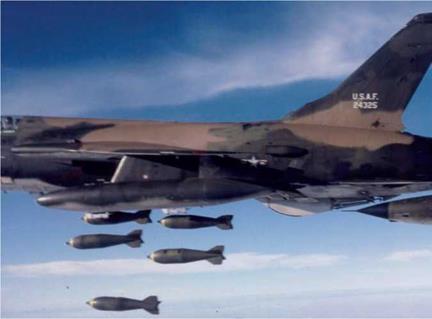F-105 GUN
The General Electric T171 cannon fitted in the nose of the F-105 revived a late 19th century design which added an electric motor to a “Gatling” rotary, multi-barrel gun. It entered production as the M61A1 in 1957, and its compactness, light weight and firing rate of up to 6,000 rounds per minute made it ideal for the F-104 Starfighter, F-105 Thunderchief and later fighters. In the F-105D, F and G, its 1,028 rounds of linkless 20 mm ammunition (allowing about ten seconds of firing) were stored in a drum that also collected empty shell cases. The hydraulically-powered gun weighed 275lbs – little more than half the weight of a full ammunition load.
F-105 MISSILES
Up to four Texas Instruments AGM-45 Shrikes could be carried by the F-105, although the usual load was two.
The ten-foot long, 390lb AGM-45A/B – the world’s first dedicated anti-radiation missile – was produced in 21 sub-variants, distinguished mainly by minor changes in their guidance sections and seeker heads. Its 147lb warhead and 18-mile effective range were limiting factors. Nevertheless, more than 18,500 were produced between 1963 and 1982. The appreciably larger General Dynamics AGM-78 Standard ARM was manufactured for the US Navy and USAF from 1967 through to 1978, the 15ft-long weapon boasting a 215lb warhead. A shortage of AGM-78s and the F-105’s high fuel consumption when carrying the bulky weapon resulted in typical ordnance loads of a single Standard and two Shrikes per jet, with a 450-gallon fuel tank “balancing” the AGM-78 on the opposite wing pylon. Although more effective than the Shrike, the Standard’s overall success rate was still only around the 20 per cent mark.
 Between April 1 and September 30, 1972, F-105Gs launched 230 AGM-78s, although there was a failure rate of more than 25 per cent in the first two months that led to a temporary “grounding” of the missile. Rocket motors were also sometimes cracked in transit, causing premature detonation – motors were x-rayed on delivery thereafter. The smaller AGM-45 proved to be quite difficult to discard in an emergency, as it lacked an explosive jettison system for either the missile or its pylon. (USAF)
Between April 1 and September 30, 1972, F-105Gs launched 230 AGM-78s, although there was a failure rate of more than 25 per cent in the first two months that led to a temporary “grounding” of the missile. Rocket motors were also sometimes cracked in transit, causing premature detonation – motors were x-rayed on delivery thereafter. The smaller AGM-45 proved to be quite difficult to discard in an emergency, as it lacked an explosive jettison system for either the missile or its pylon. (USAF)
displays and controls for the AN/APR-35, AN/APR-36 and AN/ALR-31, while the introduction of the AGM-78 missile required the installation of another control panel and 14-channel tape recorder. Key components were the IR-133 display that provided indications of “Fan Song” activity.
The AN/APR-25/26 sensors “read” the SA-2’s signals, enabling the pilot to home onto “Fan Song” emissions. The system’s cockpit display included a yellow “launch” light to show that an SA-2 was headed towards the F-105. Within the correct range and with the aircraft pointed at the threat emitter, an AGM-45 Shrike could pick up

![]() The standard bomb-load for F-105D/Fs throughout much of the war was six or eight 750lb M117 bombs, although CBU or “slick” Mk 82 bombs were often more effective against SAM sites. This 469th TFS/ 388th TFW flight is bombing “straight and level” above clouds early in 1967 – one of the most likely ways to attract a SAM that allowed insufficient time for the F-105s to avoid it. 62-4325 crashed near Korat when the flight control system failed during a test flight on March 14, 1967. (Lt Col Jack Spillers via Norman Taylor)
The standard bomb-load for F-105D/Fs throughout much of the war was six or eight 750lb M117 bombs, although CBU or “slick” Mk 82 bombs were often more effective against SAM sites. This 469th TFS/ 388th TFW flight is bombing “straight and level” above clouds early in 1967 – one of the most likely ways to attract a SAM that allowed insufficient time for the F-105s to avoid it. 62-4325 crashed near Korat when the flight control system failed during a test flight on March 14, 1967. (Lt Col Jack Spillers via Norman Taylor)
|
|
|
|
|
|
|
|
|
|
|
|










